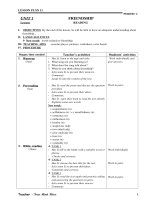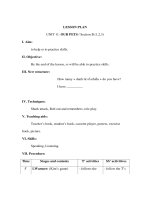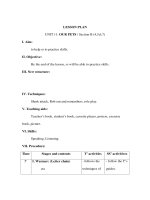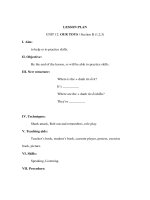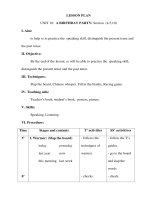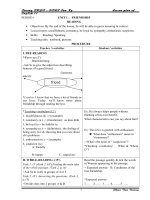Lesson Plan 11 U8.Pdf
Bạn đang xem bản rút gọn của tài liệu. Xem và tải ngay bản đầy đủ của tài liệu tại đây (427.03 KB, 10 trang )
HONG DUC UNIVERSITY
FACULTY OF FOREIGN LANGUAGES
Class:
Subject:
Lecturer:
Group:
Members:
K23A – English Language Teacher
Lesson Plan And Material Development In
English Second Language Teaching
Nguyễn Thị Quyết
No.6
Nguyễn Thị Trang
Lê Thị Lệ
Phạm Thị Huyền
Trịnh Thị Nhung
Lý Thị Hà Anh
Thanh Hóa, Octorber 10 th , 2023
1
LESSON PLAN
ENGLISH 11
Unit 8: Becoming independent learners
Lesson 5: Listening (P.91,92)
Time: 45 minutes
Student’s level: 11th grader (CEFR:A2-B1)
A. Objectives
By the end of the lesson, students will be able to: (Knowledge, skills, core
competencies, personal qualities)
1. identify different characteristics of independent learners.
2. recognize the meanings of the new words based on the context;
3. discuss the advantages of self-contained learners
4. be collaborative and supportive in pair work and teamwork
5. develop listening comprehension ability
6. show their responsibilities for becoming independent learners
B. Language Focus
Key terms: Hard-working, never give up, self-motivated, curious, and responsibility.
Key grammar: make an effort to +V, take responsibility for sth.
C. Instructional resources
• Grade 11 English textbook, Unit 8, Listening
• 1 video about a group of students learning independently
• 4 pictures about the personality and characteristics of independent learners
• Audio file (track 62 and 63)
• Computer &projector
D. Assumptions
Anticipated difficulties
- Students may lack knowledge about some
lexical items.
Solutions
- Provide students with the meaning and
pronunciation of words.
- Encourage students to work in pairs and in
groups so that they can help each other.
- Provide feedback and help if necessary.
- Students may have underdeveloping
listening skills
E.Procedures
Stage
I. WARM-UP
( 3 mins)
Aim
To create a lively
atmosphere and
positive energy in the
classroom.`
2
Procedure
-T shows the video about self-study after Ss
watch the video, they look for at least 3
adjective keywords that are necessary for
an independent learner.
Question: “What factors are necessary
for an independent student?”
Optional answer: Hard-working, selfaware, responsible, highly organized,...
II. PRELISTENING
(12 mins)
To provide students
with some lexical
items before listening
Pre-teach vocabulary
- T elicits Ss with the meaning and
pronunciation of some new words.
- T shows the pictures and asks some
questions that help Ss realize the words.
- Ss listen and repeat the words.
- T calls two or three Ss to read the words
out loud in front of the class.
- T corrects pronounciation.
1.Hard-working/ˌhɑːdˈwɜː.kɪŋ/:always
doing a lot of work
→ Chăm chỉ
2.Self-motivated(adj)/selfˈməʊ.tɪ.veɪ.tɪd/:enjoying learning
things without being forced.
new
→ Năng nổ
3.Curious(adj) /ˈkjʊə.ri.əs/:wanting to
know more about the world.
→ Tò mò
4. Never give up(phrase)/nevə gIv ʌp/:
trying very hard to complete a task.
3
→Đừng bỏ cuộc
5.Responsibility(adj) /ri,spɔnsə'biləti/: be
responsible for something or somebody.
→Trách nhiệm
III. WHILELISTENING
(20 mins)
To prepare students
for the content of the
listening lesson
Task 1: Tick the columns.
(Activity 1 page 91 in the textbook)
-T asks Ss to look at the title and the table.
-T asks Ss to read through the question in
the table and explain if Ss don’t understand
these questions.
- T asks Ss to tick the columns and compare
their answers with a partner.
- T invites some pairs to share their answers
with the whole class.
-T gives the feedback.
For example, if when Ss have 3 ‘yes’
answers or more, T can say they have
characteristics of independent learners.
To help students
practice listening skill
Task 2: Choose the correct answers A, B,
or C
(Activity 2 on page 91 in the textbook)
- T tells Ss that they are going to listen to a
conversation between Mai and Mike.
- T gives Ss 2 minutes to read the questions,
and the choices and underline the keywords
before listening to the record.
- T makes sure that Ss understand the
vocabulary. Elicit or explain any unfamiliar
or difficult strutures.
Explain:
-make an effort to +V(phr.v):Cố gắng để
làm gì đó.
4
-take responsibility for sth(phr.v):Chịu
trách nhiệm cho việc gì.
- T plays the radio.
- If Ss have not heard clearly or have not
answered some questions, T plays the radio
for the second time.
- T calls some Ss to answer the question and
asks them why they chose it and what they
hear
- T check Ss’ answer.
- If necessary, play the recording again,
pausing at the places where Ss can get the
correct answers for questions testing specific
information.
-Key:1-c, 2-a, 3-b, 4-b.
Task 3: Fill in the blank with no more
than three words or a number.
- T adapts short answers into exercise filling
in the blanks and divides the class into
pairs.
There are 4 sentences with 7 missings in the
worksheet which T will give each pair
before listening.
- T gives Ss 2 minutes to read the questions,
and the choices and underline the keywords
before listening to the record.
- T plays the audio.
- After that, T calls three pairs to write down
their answers on the board.
-T checks answers and gives them feedback.
Questions:
1. There are …… characteristics of
independent learners that Mike finds on
the website.
2. Independent learners never wait for
…….. or …….. to help them and tell them
what to do.
3. They take responsibility for …………..
4.They make …………to achieve their
learning goals .
5. They are not afraid of ………….
Key:
1:4( four)
2. their parents/ teachers
3. their own learning
4. (detailed) study plans
5. asking difficult questions.
5
IV. POSTLISTENING
(8 mins)
- To check students’
fluency and
understanding in
listening tasks.
- To help Ss show
their responsibility for
self-study
Task 4: Discussion
(Activity 4 on page 92 in the textbook)
- T divides the class into many small
groups(2 tables are in a group)
- T gives a question and some suggestions.
+ Question:“ Which of the characteristics
of independent learners do you think you
have?”
+Suggestion: hard-working, selfmotivated, responsible, curious, highly
organized...
- Ss note down and work in groups for
around 2 minutes.
- T calls 2 pairs of students randomly from
groups, and then they will ask and answer
each other in front of the class.
-T checks and gives feedback for Ss.
V. WRAP-UP
AND
HOMEWORK
(2 mins)
To help students
memorize the target
language and skills
that they have learned.
WRAP-UP:
- Ask students to answer the following
questions:
1. What did you learn from the lesson
today?
(Recognize the characteristics of
independent learners and how to practice
self-study)
2. What are the core values of the lesson?
(Ss realize the personality of independent
learners and concentrate on developing
skills based on characteristics that they
have)
HOMEWORK
- Prepare for the next lesson: Unit 8:
Writing.
- Do exercises in the workbook.
6
LESSON PLAN
ENGLISH 11
UNIT 8: Becoming independent
Lesson 6: Writing (p.92)
Time: 45 mins
th
Student’s level: 11 grader (CEFR: A2 – B1)
A. Objectives
By the end of the lesson, students will be able to: (Knowledge, core competences, personal
qualities)
- Use lexical items related to the topic self-study.
- Write an article about the pros and cons of self-study.
- Be collaborative and supportive in pair work and teamwork.
- Actively join in class activities.
- Develop writing skills.
- Show their responsibilities for learning by themselves.
B. Language Focus
Key grammar/ Structure: useful expressions to express the pros and cons, and outline of an
article.
C. Instructional resources
- Grade 11 English textbook, Unit 8, Writing
- A video about the importance of self-study
- A picture related to self-study
- A flag
- A sample writing about the pros and cons of self-study
- Computer &projector
D. Assumptions
Anticipated difficulties
Solutions
- Students may lack knowledge about some - Guide students to make an outline first before
lexical items.
writing.
- Encourage students to work in pairs and in
- Students may have underdeveloping writing groups so that they can help each other.
skills
- Provide feedback and help if necessary.
E. Procedures
Stage
I. WARM-UP
(3 mins)
II. PREWRITING
Aim
- To create a friendly
and lively atmosphere
in the classroom
- To get Ss interested in
the topic
Procedure
- T plays a video on self-study and asks a question:
“What does video talk to?” (The importance of selfstudy)
- Ss watch the video, discuss, and guess the main
content of the video.
- T gives feedback, if necessary, then introduces the
lesson.
To help Ss to develop Task 1: Play a mini-game.
ideas for their writing (Activity 1 on page 92 in the textbook)
and provide more
7
( 12 mins)
useful words
phrases.
and - Before doing this task, T asks Ss to pay attention
to the title and the picture and answer the questions:
+ What does the picture show? (A girl, books,
laptop)
+ What is she doing? (She is studying.)
+ Is she studying on her own? (Yes, she is)
+ Do you know what pros and cons mean? (Pros
means tích cực, Cons means tiêu cực)
- T tells them to look at the table and read through
the statements.
- T explains new words if necessary.
1. freedom (adj): tự do
2. push (v): thúc ép
3. responsible (adj): có trách nhiệm
4. academic skills: kĩ năng học thuật
- T organizes this task into a game called "Catch the
flag". T explains the rule.
- Rule: T calls 6 students randomly. T divides them
into 2 groups. Each group includes 3 members.
They have 10 seconds to read the sentences and
quickly catch the flag to take the opportunity to
answer whether the sentence is pro or con.
- Answer: Pros (1,3,5), Cons (2,4,6)
To help Ss remember * Task 2: Work in pairs. Arrange the following
the main content of sentences to fill with the outline below.
each part of an article. a. A summary of the main points and sometimes the
writer’s opinion.
b. A short paragraph stating the issue and what the
article will cover.
c. The topic of the article in a few words.
d. Each presents a main point for or against the
issue, supported by facts, examples, and
explanations.
Outline of an article
1. Title:..........................................................
2. Introduction:..............................................
3. Body paragraphs:......................................
4. Conclusion:...............................................
8
- T explains the task and requires Ss to do this task
to review the structure and content of an article.
- T sets time to Ss complete the task.
- T calls 2 Ss to write their answer on the board.
- T checks and provides a full outline.
Answers: 1.c, 2.b, 3.d, 4.a
- T asks Ss to refer back to the suggested ideas in
task 1 and study the outline with the expressions in
the box on page 92 in textbook.
III. WHILE- To help Ss practice
WRITING
writing an article about
the pros and cons of
(18 mins)
self-study.
Task 3: Write an article about the pros and cons
of self-study.
(Activity 2 on page 92 in the textbook)
- T explains the task.
- T reminds Ss to provide detailed explanations or
examples to support each idea in a paragraph.
E.g. Self-study gives learners more freedom. They
decide what they should study and how to study
depending on their abilities.
- T requires Ss to write an article (150-180 words)
based on the information in the diagram from the
previous activity.
- T sets a time limit for Ss to write in class.
IV.
POST- To check Ss’ writing - T requires Ss to swap their writing with a partner
WRITING
and
correct
their for peer feedback.
mistakes.
(10 mins)
- T asks them to focus on the content, language, and
structure in their comments.
- T ecourages Ss to make some revisions based on
their partners’ suggestions before they produce an
edited draft.
- T collects some Ss' writings and gives them with
some written feedback.
- T shows sample to other Ss can compare with
their article.
Sample answer:
Pros and cons of self-study
Independent learning often involves self-studylearning at home without a teacher. Let's look at its
pros and cons.
First of all, self-study gives learners more freedom.
They decide what they should study and how to
study depending on their abilities. Secondly, it can
make learners responsible. They set their learning
goals and make study plans to achieve them.
Finally, it makes them more confident. Completing
tasks and solving problems on their own boost
learners' confidence.
On the other hand, learners may need more time to
learn things. They study at their own pace, with no
9
one to push them or help them. Moreover, they may
not develop certain life skills. For example, as they
always study alone, they may have difficulty
communicating or developing relationships.
Finally, they may not learn practical skills.
Focusing too much on theoretical knowledge, they
may fail to apply their academic skills in real life.
In conclusion, learners should understand both the
advantages and disadvantages to choose the right
option. However, as education is changing all the
time, they may have to get used to the challenges of
independent learning.
- T asks Ss to read the sample and correct their
mistakes and complete their writing.
- T collects others’ writings and gives them written
feedback in the next lesson.
V. WRAP-UP To help Ss memorize
AND
the target language and
HOMEWORK skills that they have
learned.
WRAP-UP
- Ask Ss to talk about what they have learned in the
lesson.
HOMEWORK
- Do workbook exercises
- Prepare for the next lesson.
10



